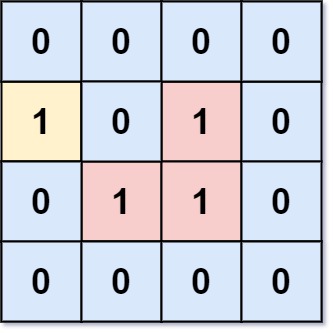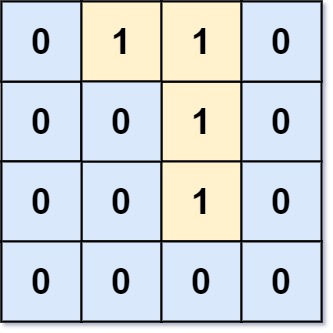- {x}
- Numbers With Repeated Digits
- Partition Array Into Three Parts With Equal Sum
- Best Sightseeing Pair
- Smallest Integer Divisible by K
- Binary String With Substrings Representing 1 To N
- Convert to Base -2
- Binary Prefix Divisible By 5
- Next Greater Node In Linked List
- Number of Enclaves
- Remove Outermost Parentheses
- Sum of Root To Leaf Binary Numbers
- Camelcase Matching
- Video Stitching
- Divisor Game
- Maximum Difference Between Node and Ancestor
- Longest Arithmetic Subsequence
- Recover a Tree From Preorder Traversal
- Read More...

Number of Enclaves
You are given an m x n binary matrix grid, where 0 represents a sea cell and 1 represents a land cell.
A move consists of walking from one land cell to another adjacent (4-directionally) land cell or walking off the boundary of the grid.
Return the number of land cells in grid for which we cannot walk off the boundary of the grid in any number of moves.
Example 1:

Input: grid = [[0,0,0,0],[1,0,1,0],[0,1,1,0],[0,0,0,0]] Output: 3 Explanation: There are three 1s that are enclosed by 0s, and one 1 that is not enclosed because its on the boundary.
Example 2:

Input: grid = [[0,1,1,0],[0,0,1,0],[0,0,1,0],[0,0,0,0]] Output: 0 Explanation: All 1s are either on the boundary or can reach the boundary.
Constraints:
m == grid.lengthn == grid[i].length1 <= m, n <= 500grid[i][j]is either0or1.
Solution Explanation for Number of Enclaves
This problem asks to find the number of land cells (represented by 1s) in a binary matrix that are completely enclosed by sea cells (represented by 0s) and cannot be reached from the boundary of the matrix. We can solve this using Depth-First Search (DFS), Breadth-First Search (BFS), or Union-Find. Here's a detailed explanation of the DFS and BFS approaches, along with complexity analysis:
Approach 1: Depth-First Search (DFS)
This approach uses DFS to identify and mark all land cells connected to the boundary. Any remaining land cells are enclosed.
Algorithm:
-
Initialization: Iterate through the boundary of the grid. If a land cell is found, perform a DFS starting from that cell.
-
DFS: The DFS function recursively explores adjacent land cells, marking them as visited (changing their value to 0). It continues until it reaches a boundary or all connected land cells are visited.
-
Counting Enclaves: After the DFS, iterate through the grid again. The sum of the remaining 1s represents the number of enclosed land cells.
Code (Python):
def numEnclaves(grid):
m, n = len(grid), len(grid[0])
def dfs(i, j):
if i < 0 or i >= m or j < 0 or j >= n or grid[i][j] == 0:
return
grid[i][j] = 0 # Mark as visited
dfs(i + 1, j)
dfs(i - 1, j)
dfs(i, j + 1)
dfs(i, j - 1)
for i in range(m):
dfs(i, 0) # Check left boundary
dfs(i, n - 1) # Check right boundary
for j in range(n):
dfs(0, j) # Check top boundary
dfs(m - 1, j) # Check bottom boundary
count = 0
for i in range(m):
for j in range(n):
if grid[i][j] == 1:
count += 1
return count
Time Complexity: O(M*N), where M and N are the dimensions of the grid. We visit each cell at most once.
Space Complexity: O(M*N) in the worst case for the recursion stack during DFS (though it can be reduced to O(1) if an iterative approach with a stack is used instead).
Approach 2: Breadth-First Search (BFS)
This approach is similar to DFS, but uses a queue instead of recursion.
Algorithm:
-
Initialization: Find all land cells on the boundary and add them to a queue. Mark these cells as visited (change to 0).
-
BFS: While the queue is not empty, dequeue a cell and explore its adjacent cells. If an adjacent cell is a land cell, add it to the queue and mark it as visited.
-
Counting Enclaves: Similar to DFS, count the remaining 1s in the grid.
Code (Python):
from collections import deque
def numEnclaves(grid):
m, n = len(grid), len(grid[0])
q = deque()
for i in range(m):
if grid[i][0] == 1:
q.append((i, 0))
grid[i][0] = 0
if grid[i][n - 1] == 1:
q.append((i, n - 1))
grid[i][n-1] = 0
for j in range(n):
if grid[0][j] == 1:
q.append((0, j))
grid[0][j] = 0
if grid[m - 1][j] == 1:
q.append((m - 1, j))
grid[m - 1][j] = 0
while q:
i, j = q.popleft()
for x, y in [(i + 1, j), (i - 1, j), (i, j + 1), (i, j - 1)]:
if 0 <= x < m and 0 <= y < n and grid[x][y] == 1:
q.append((x, y))
grid[x][y] = 0
count = sum(sum(row) for row in grid)
return count
Time Complexity: O(M*N)
Space Complexity: O(M*N) in the worst case, for the queue.
Approach 3: Union-Find (Not shown in detail, but mentioned in the problem description)
Union-Find can also be used to solve this problem. It would involve creating a disjoint-set data structure to connect land cells. Cells connected to the boundary would be grouped into one set. The number of elements in other sets would represent the enclosed lands. This approach has similar time complexity to DFS and BFS.
Note: The provided code examples use different helper functions (pairwise in Python) or different ways to handle adjacent cells. The core logic of DFS or BFS remains the same across different programming languages.